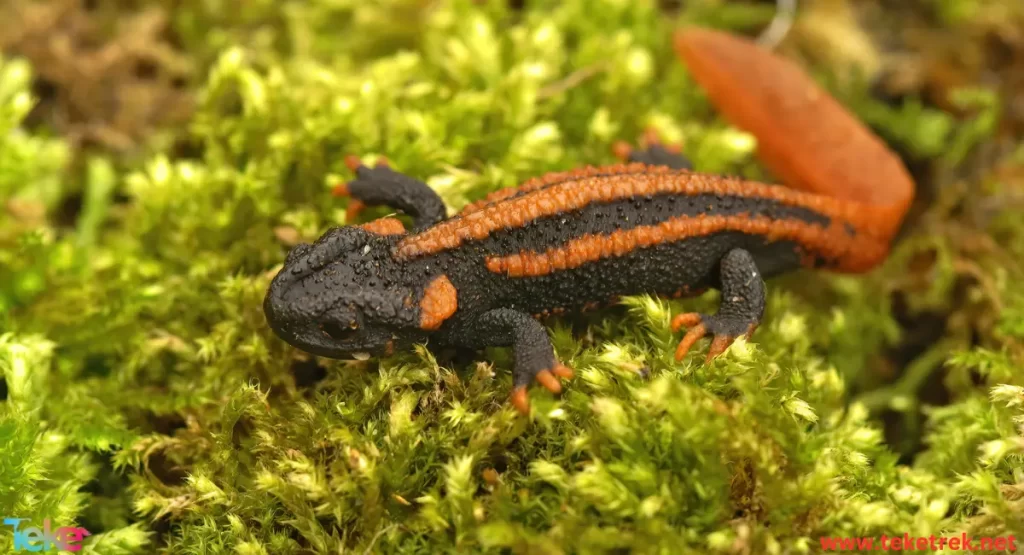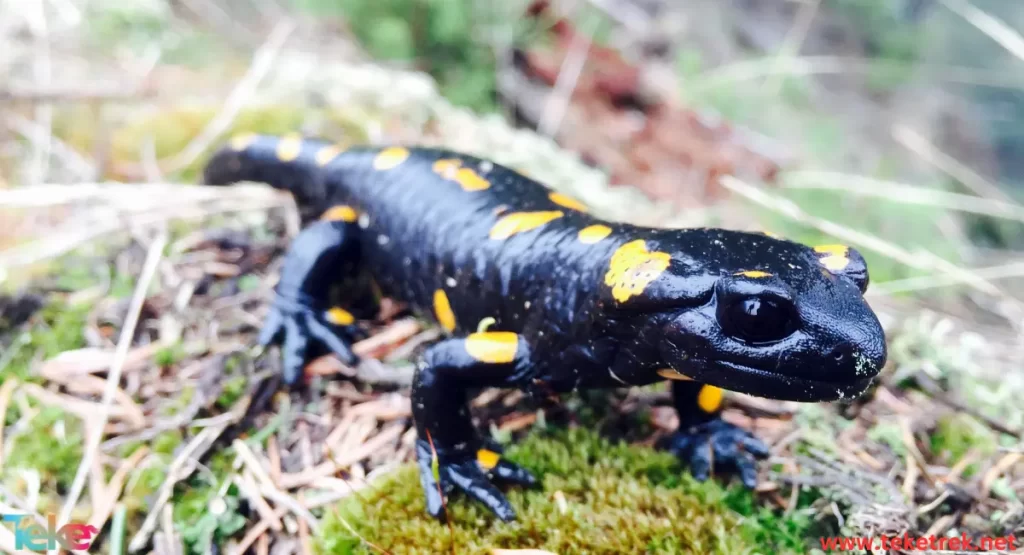The salamander is an amazing animal, and one of the most interesting creatures on Earth.
The amazing salamander varies in its forms, sizes, and colors, and it is one of the most interesting creatures on Earth.
The salamander is skilled at hiding under rocks, as well as moving between them.
Let’s learn together some facts about this creature from teketrek..

Important information about salamanders: Discover amazing facts!
The scientific name for the salamander is: Urodela. A member of the phylum Chordata, the phylum Vertebrata, and the class Amphibia.The salamander is an amphibian that lives in water and on land.
- It has a lizard-like appearance, and Salamander means fire lizard.
- It is a cold-blooded vertebrate, meaning it depends on the external temperature to regulate its body temperature.
- It is called a tailed creature or a newt, and it is the only amphibian that has a tail when it reaches maturity.
- The salamander is considered a small reptile.
- Its body is characterized by being slender and elongated, with a short nose and a long tail.
- The salamander has short legs.
- The head of the salamander is triangular in shape, and it has two wide eyes located on the sides of the head.
- The teeth of the salamander are small and sharp, located on the sides of the jaw.
- The salamander is known for its moist and smooth skin.
- The salamander is a quadruped, meaning it has four toes on the front limbs, and five toes on the hind limbs, and it does not have claws.
- The colors of the salamander vary, including red, black, blue, yellow, and orange, with different spots from the color of its body.
- The length of the salamander ranges from several centimeters to a meter and a half.
- While the weight of the salamander ranges between 120-200 grams.
- Some types live for very long periods, such as the Chinese giant salamander.
- It lives for a period ranging between 55 to 75 years.
- The salamander breathes through gills, lungs, and skin.
- The skin of the salamander secretes a mucous substance, which helps it stay moist while in dry areas.
- This substance also helps maintain the balance of salts when it is in the water, in addition to providing it with fats during swimming.
- The salamander changes the outer layer of its skin during its growth stages, then eats this layer.
- The salamander has an amazing ability to regenerate its limbs, which it loses while defending itself.
- It can also regenerate the spinal cord, brain tissues, and even parts of its heart.
- It is said that they grow back completely within just two weeks.
- The size of the salamander’s tongue is ten times the size of its body.
- There are more than 500 species of it in the world.
- The salamander is active and feeds at night, while it hides during the day in burrows and rock crevices to avoid predators.
- The salamander displays its poisonous nature through its bright colors; when the salamander’s color is shiny, it indicates that it is poisonous.
- The salamander is affected by temperature changes, where it hibernates when temperatures drop, then returns to the same hibernation site every year.
- Salamanders communicate through touch, as they do not have a voice.
- Salamanders secrete substances with a bad taste to ward off predators.
- Salamanders move slowly, but they can move and jump quickly if they feel threatened.
- Despite lacking physical features that help with flying, they master some movements that reduce their falling speed to land gently and gracefully.
- Salamanders walk on the ground, on trees, or at the bottom of water pools, while some species can swim.
- It is said that salamanders can live in fire without suffering any harm.
- It is also rumored that they can extinguish fire due to their body’s cold nature.
- Besides, sometimes salamanders are not suitable for consumption by predators due to the presence of mucus containing bitter substances that make them unpalatable.
What is the salamander’s diet?
Salamanders are carnivorous, feeding on young frogs and vertebrates, as well as snails and slugs.
Salamanders also feed on many animals such as spiders, worms, mollusks, as well as mosquito larvae, fly larvae, cockroaches, and mollusks.
They can also eat fish, where aquatic salamanders catch their prey by extending their sticky tongue to stick to the prey and pull it into their mouth.
Where are salamanders found?
Salamanders are found all over the world except for the South Pole and Australia.
Salamanders live in the Americas and Canada, as well as in Europe, Mediterranean regions, Africa, and Asia. In addition to Japan and Taiwan.
Many salamanders inhabit moist forests, where they take refuge in crevices, leaves, fallen trunks, and other debris.
Salamander breeding stages: Discovering Life from Beginning to End!
90% of salamander species undergo internal fertilization, meaning the male places the sperm on the ground or rocks.
The number ranges from 80-100 sperm in the form of bundles.
Then, the female salamander introduces the sperm with her lip into the cloacal opening.
The female lays eggs in a moist place, where she can lay more than 200 eggs in a single breeding season.
In addition, some female salamanders, like the European fire salamander, retain the eggs inside them until they reach the larval stage.
Some salamander species undergo external fertilization, where the female lays eggs in nests. Then the male fertilizes the eggs and monitors them until they hatch after 2-3 months.
Harms and benefits of salamanders: How do salamanders affect our environment?
Its skin contains toxins that can be dangerous to humans if swallowed.
Salamanders contribute to maintaining the balance of insect and arthropod populations by preying on them.
They benefit humans in pest control, such as ticks and mosquitoes.
Salamanders help reduce diseases spread by rodents by reducing the number of pests they feed on.
Salamanders feed on many insects that contribute to crop damage.
Salamanders help reduce the effects of global warming by feeding on invertebrates such as beetles, earthworms, snails, and ants, which release carbon dioxide.
From Giant to Tiny: Meet the Amazing Types of Salamanders!
Red-backed Salamander:
This type breathes through its skin, as it does not have lungs. It is characterized by a gray color with a red stripe down the back, while its belly is spotted with white and gray. This species lays its eggs in moist forests.
- Jefferson’s Salamander: This salamander is long and slender, with a broad nose, and is distinguished from other species by having longer toe fingers.
- Spotted Salamander: Lives in the forest or in burrows, where it lays its eggs among branches or rocks, laying from 100 to 300 gelatinous eggs. It can reach a length of 22.8 cm and can live for more than 20 years.
- Marble Salamander: Characterized by its black color with silver bands, it breeds in the fall, and lays eggs in low-lying areas. Its eggs hatch in the fall or winter.
- Green Salamander: This type is characterized by having yellow or green spots, with a slender and flat body, while the head is swollen behind the eyes, and the toes are square.
- Chinese Giant Salamander: The largest amphibian in the world, reaching a length of 1.8 meters and weighing about 50 kg. It lives underwater.
- Salamander Bird: Found in India, it eats many plants such as ginger, and it is said that this bird enjoys fire and does not burn in it, spending most of its time in the fire.

FAQs about salamander
- Is the salamander poisonous?
Not all salamanders are poisonous, but some species, such as the rough-skinned newt (Taricha granulosa), produce toxins in their skin as a defense mechanism against predators.
- How does a salamander reproduce?
Reproduction occurs through live
birth, about 2 to 3 weeks after the male fertilizes the female (and fertilization occurs in terrestrial or dry areas, the eggs are fertilized and hatch inside the female’s body, then she gives birth, or the eggs are laid in water and the young grow slowly and are sensitive in the first weeks, and their growth occurs in water, then they gradually leave to become terrestrial).
In conclusion, after our tour of the life of this strange creature, it appears attractive in some of its types, and it is indeed a beautiful and wonderful species. Undoubtedly, the “Wandering Salamander,” which you find soaring high among the mountain peaks, with exceptional skill in controlling its direction and reducing its speed during descent, is a testament to the capabilities of this amazing being.





